Global

Harnessing Geospatial Data through GeoNode
With missing or inadequate risk information hindering resilience in many developing countries, GFDRR developed GeoNode, a web-based, open source software that enables users to access, share, and visualize geospatial data. Today, GeoNode is a public good relied on by hundreds of organizations around the world.
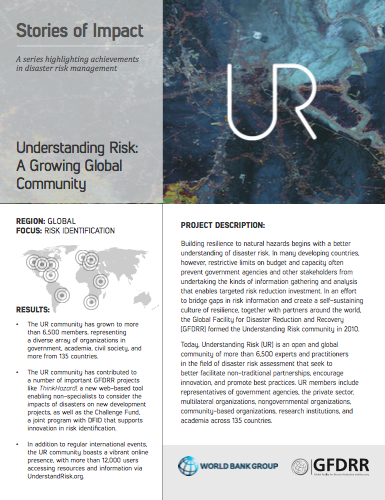
Understanding Risk: A Growing Global Community
In an effort to bridge gaps in risk information and create a self-sustaining culture of resilience, together with partners around the world, GFDRR formed the Understanding Risk (UR) community in 2010. Today, UR is an open and global community of more than 6,500 experts and practitioners in the field of disaster risk assessment, representing a diverse array of organizations in government, academia, civil society, and more from 135 countries. The UR community seek to better facilitate non-traditional partnerships, encourage innovation, and promote best practices.
Africa
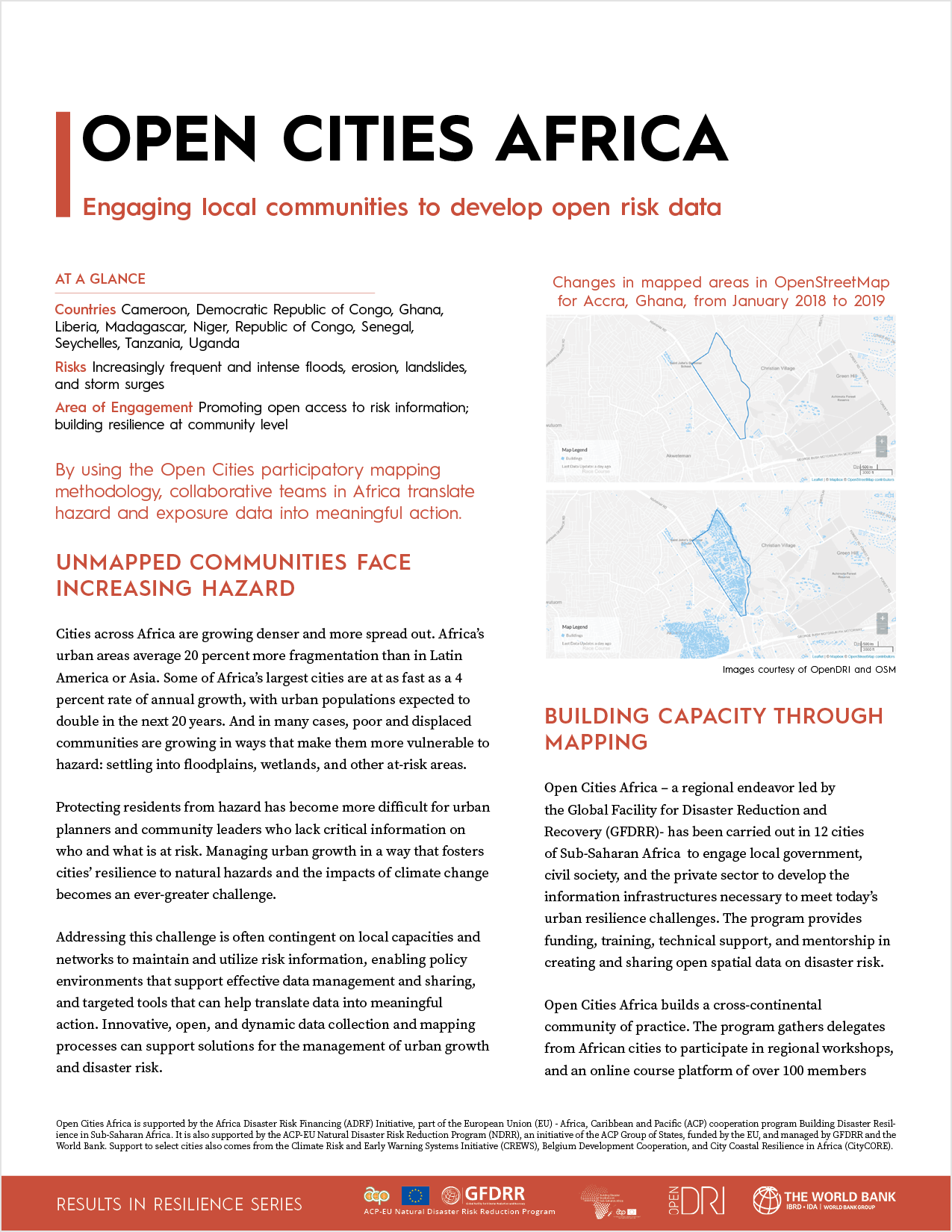
Open Cities Africa
Engaging local communities to develop open risk data
By using the Open Cities participatory mapping methodology, collaborative teams in Africa translate hazard and exposure data into meaningful action.
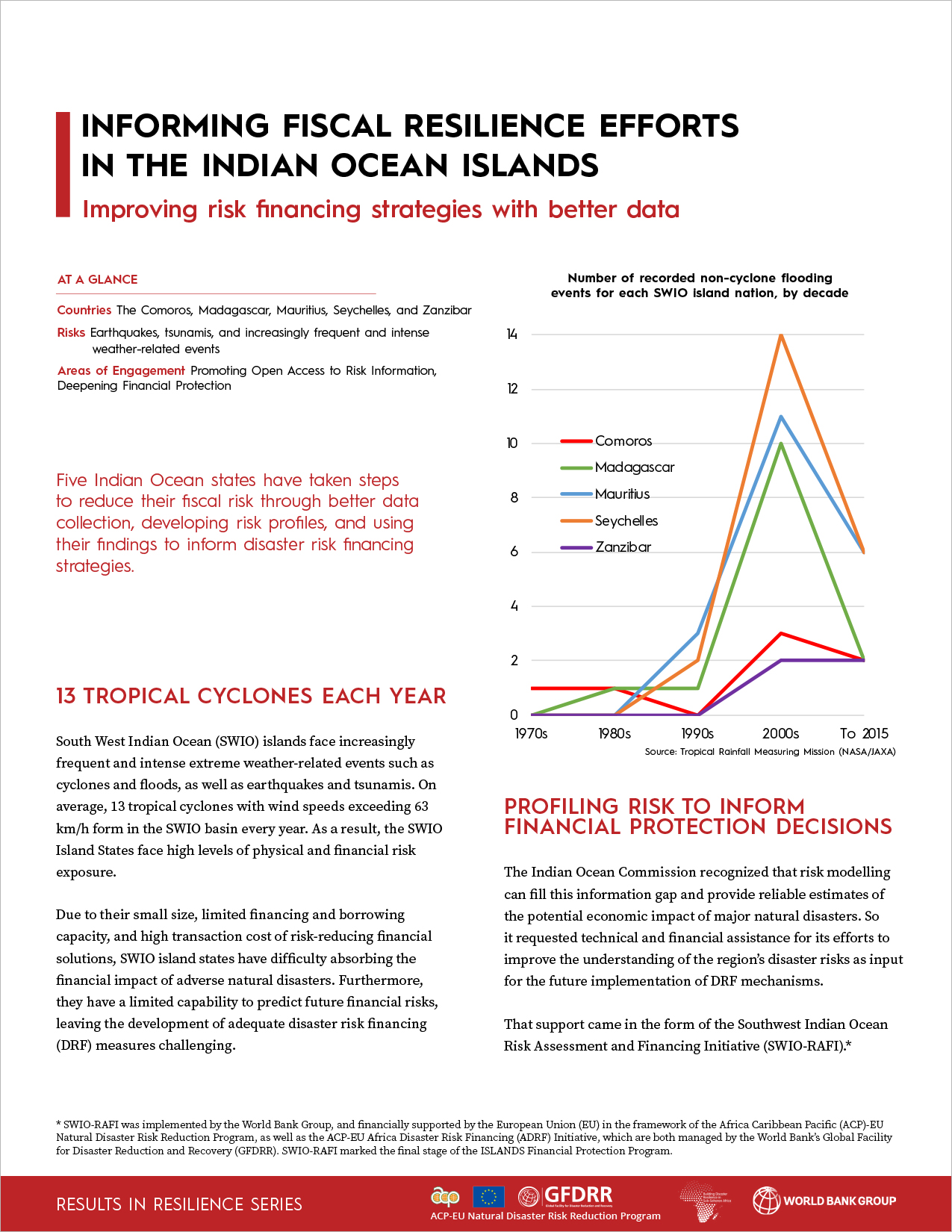
Informing Fiscal Resilience Efforts in the Indian Ocean Islands
Improving risk financing strategies with better data
Five Indian Ocean states have taken steps to reduce their fiscal risk through better data collection, developing risk profiles, and using their findings to inform disaster risk financing strategies.
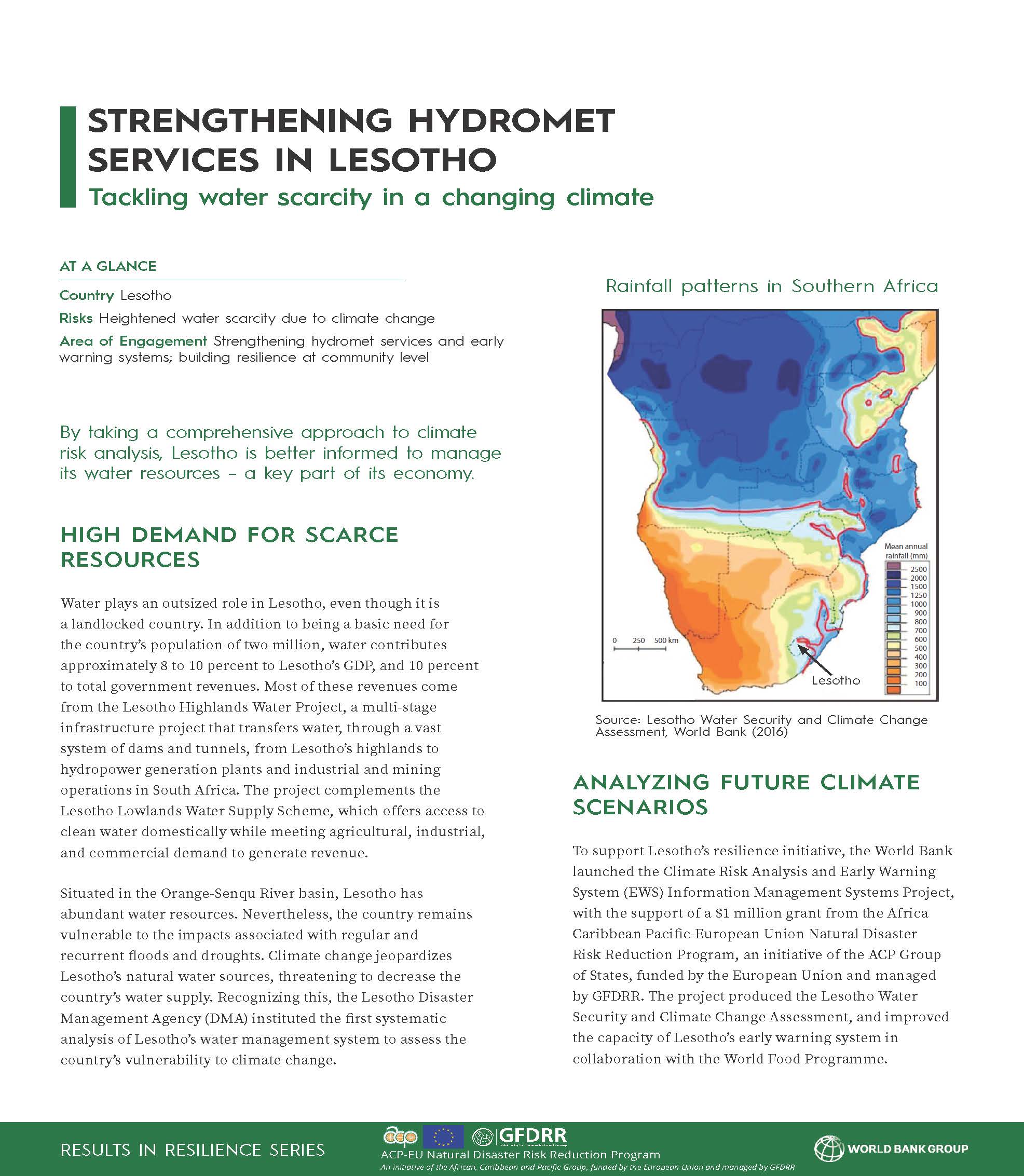
Strengthening Hydromet Services in Lesotho
Tackling water scarcity in a changing climate
By taking a comprehensive approach to climate risk analysis, Lesotho is better informed to manage its water resources – a key part of its economy.
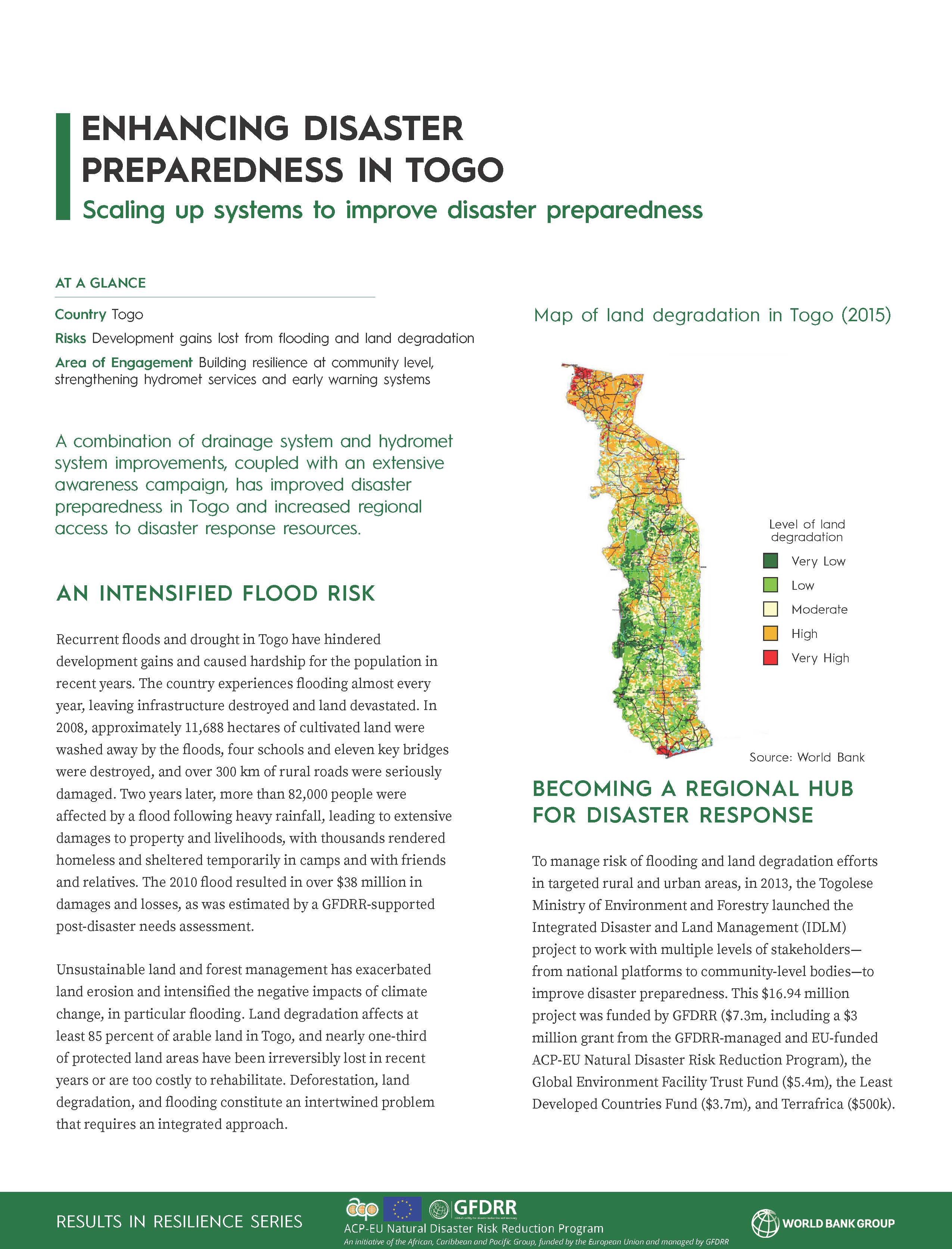
Enhancing Disaster Preparedness in Togo
Scaling up systems to improve disaster preparedness
A combination of drainage system and hydromet system improvements, coupled with an extensive awareness campaign, has improved disaster preparedness in Togo and increased regional access to disaster response resources.
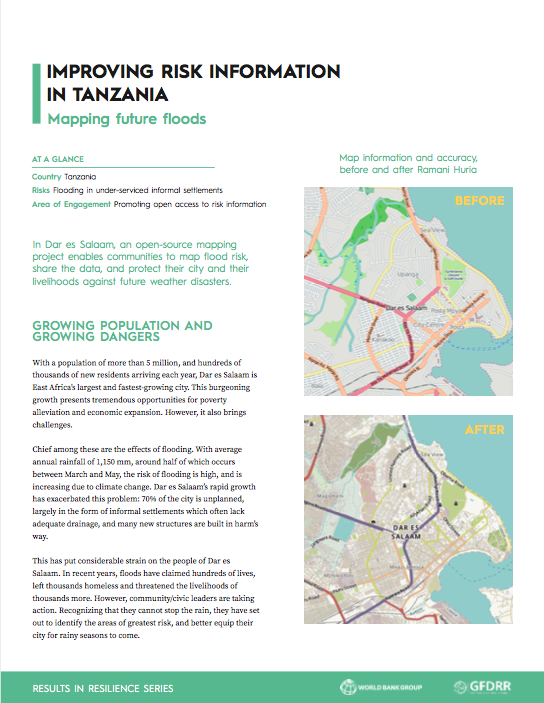
Improving Risk Information in Tanzania
Mapping future floods
In Dar es Salaam, an open-source mapping project enables communities to map flood risk, share the data, and protect their city and their livelihoods against future weather disasters.
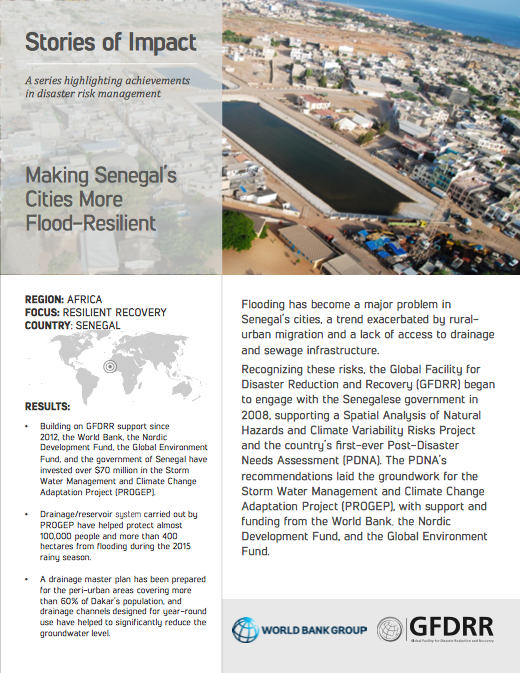
Making Senegal's Cities More Flood-Resilient
Building on GFDRR support since 2012, the World Bank, Norway, Japan, and the government of Senegal have invested over $70 million in the Storm Water Management and Climate Change Adaptation Project to build drainage and sewage infrastructure and reduce the impact of flooding.
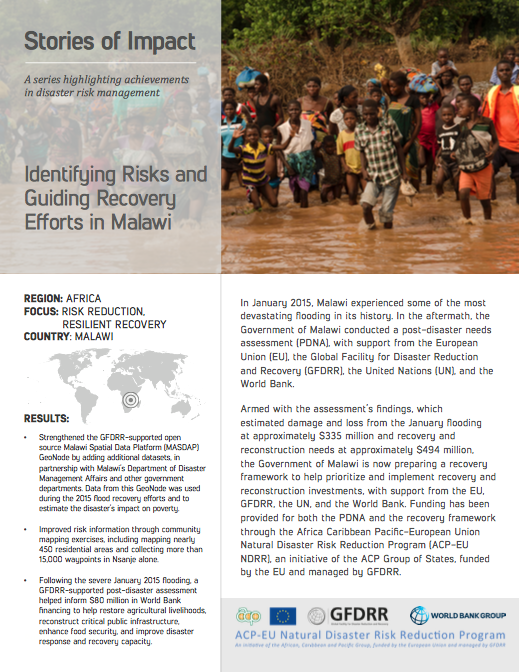
Identifying Risk and Guiding Recovery Efforts in Malawi
In January 2015, Malawi experienced some of the most devastating flooding in its history. In the aftermath, the Government of Malawi conducted a post-disaster needs assessment (PDNA), with support from the European Union (EU), the Global Facility for Disaster Reduction and Recovery (GFDRR), the United Nations (UN), and the World Bank.
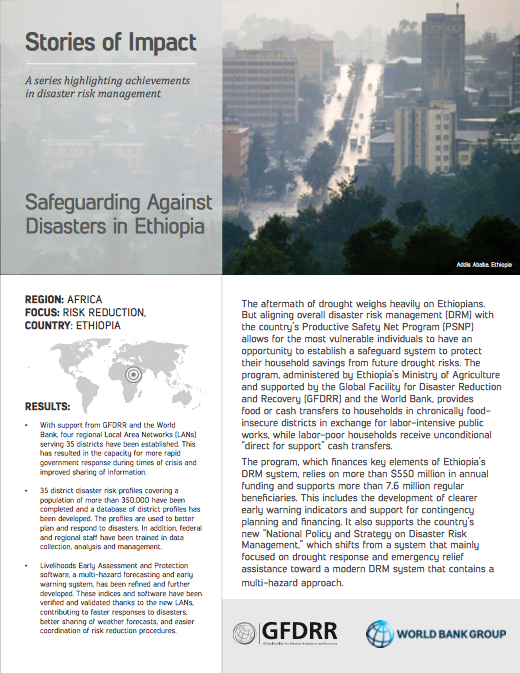
Safeguarding Against Disasters in Ethiopia
The World Bank and GFDRR are supporting the development of clearer early warning indicators and support for contingency planning and financing in Ethiopia, as well as the new National Policy and Strategy on Disaster Risk Management.
Building Stronger Classrooms to Weather Disasters in Mozambique
The World Bank and GFDRR provided financial and technical assistance to support Mozambique's efforts to develop school safety guidelines for classroom facilities across the country.
Assessing Post-Disaster Needs in Nigeria
After severe flooding in 2012, Nigeria asked GFDRR and other key partners to conduct a comprehensive Post-Disaster Needs Assessment (PDNA).
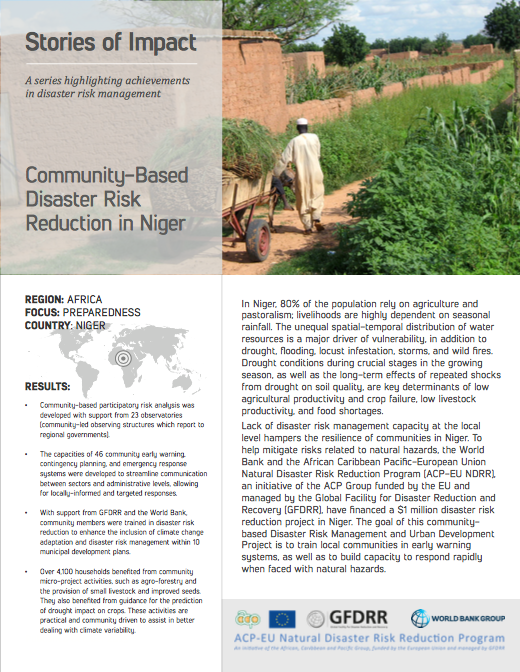
Community-Based Disaster Risk Reduction in Niger
GFDRR and partners have financed an almost $1 million disaster risk reduction project in Niger to build capacity of local communities for early warning and response.

Weathering Future Storms in the Seychelles
When Tropical Cyclone Felleng battered the multi-island country of Seychelles with heavy rain in January 2013, the government, with support from the World Bank and the Africa Caribbean Pacific-European Union Natural Disaster Risk Reduction (ACP-EU NDRR) Program, an initiative managed by the Global Facility for Disaster Reduction and Recovery (GFDRR), worked to assess the damages and ensure that recovery efforts mitigate the effects of future natural hazards.
East Asia and Pacific

Using UAVs to Assess Disaster Risk in Fiji & Tonga
Developing the capacity and readiness of Pacific Island countries
By developing local capacity to generate data on disaster risk, countries like Fiji and Tonga can carry out more analysis and make decisions based on evidence.
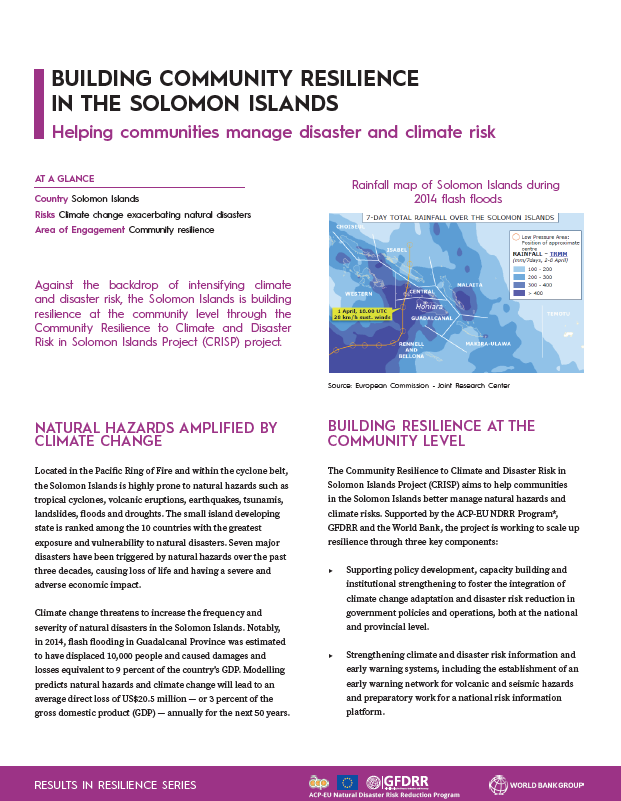
Building Community Resilience in the Solomon Islands
Helping communities manage disaster and climate risk
Against the backdrop of intensifying climate and disaster risk, the Solomon Islands is building resilience at the community level through the Community Resilience to Climate and Disaster Risk in Solomon Islands Project (CRISP) project.
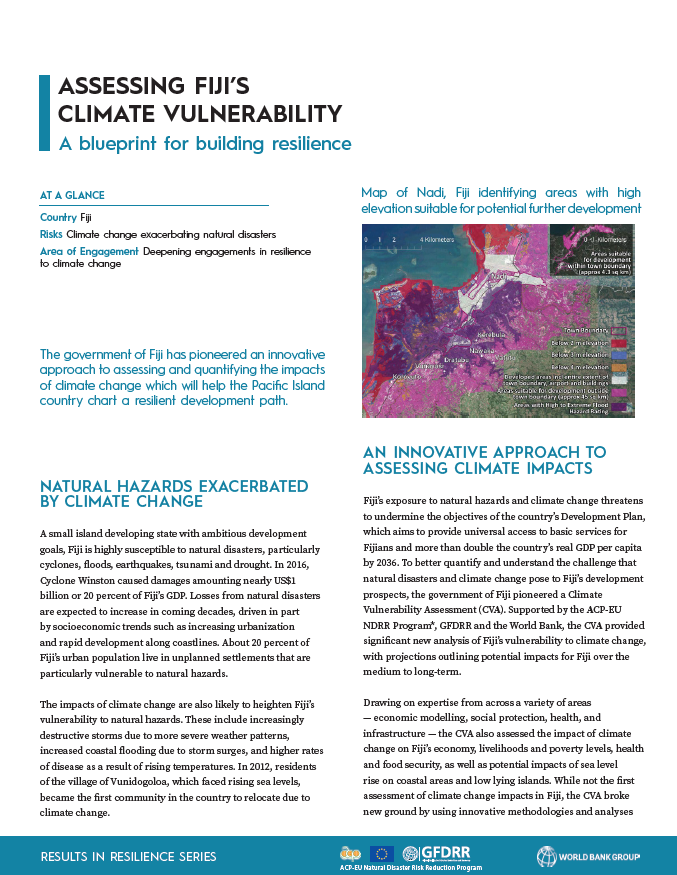
Assessing Fiji's Climate Vulnerability
A blueprint for building resilience
The government of Fiji has pioneered an innovative approach to assessing and quantifying the impacts of climate change which will help the Pacific Island country chart a resilient development path.
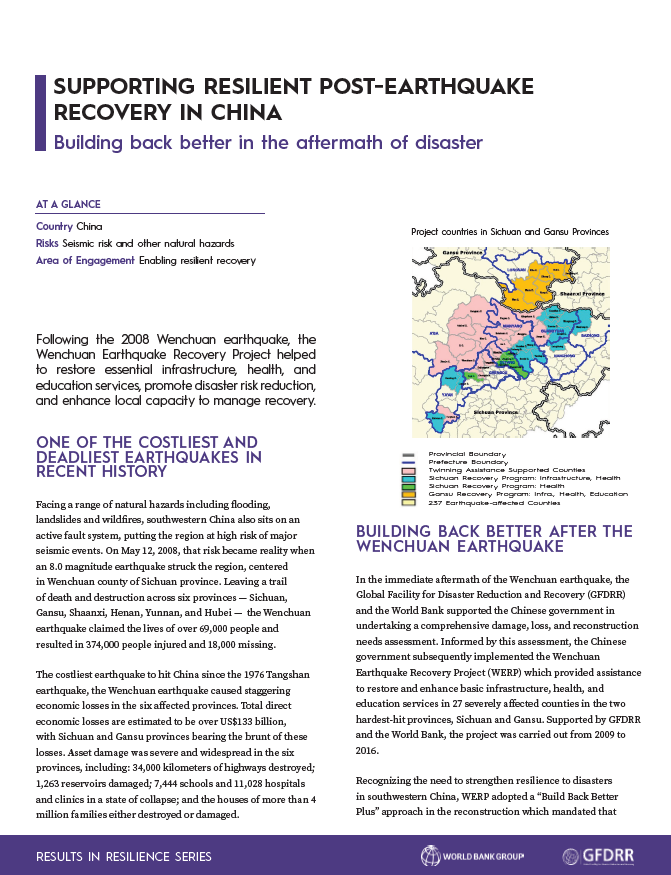
Supporting Resilient Post-Earthquake Recovery in China
Building back better in the aftermath of disaster
Following the 2008 Wenchuan earthquake, the Wenchuan Earthquake Recovery Project helped to restore essential infrastructure, health, and education services, promote disaster risk reduction, and enhance local capacity to manage recovery.
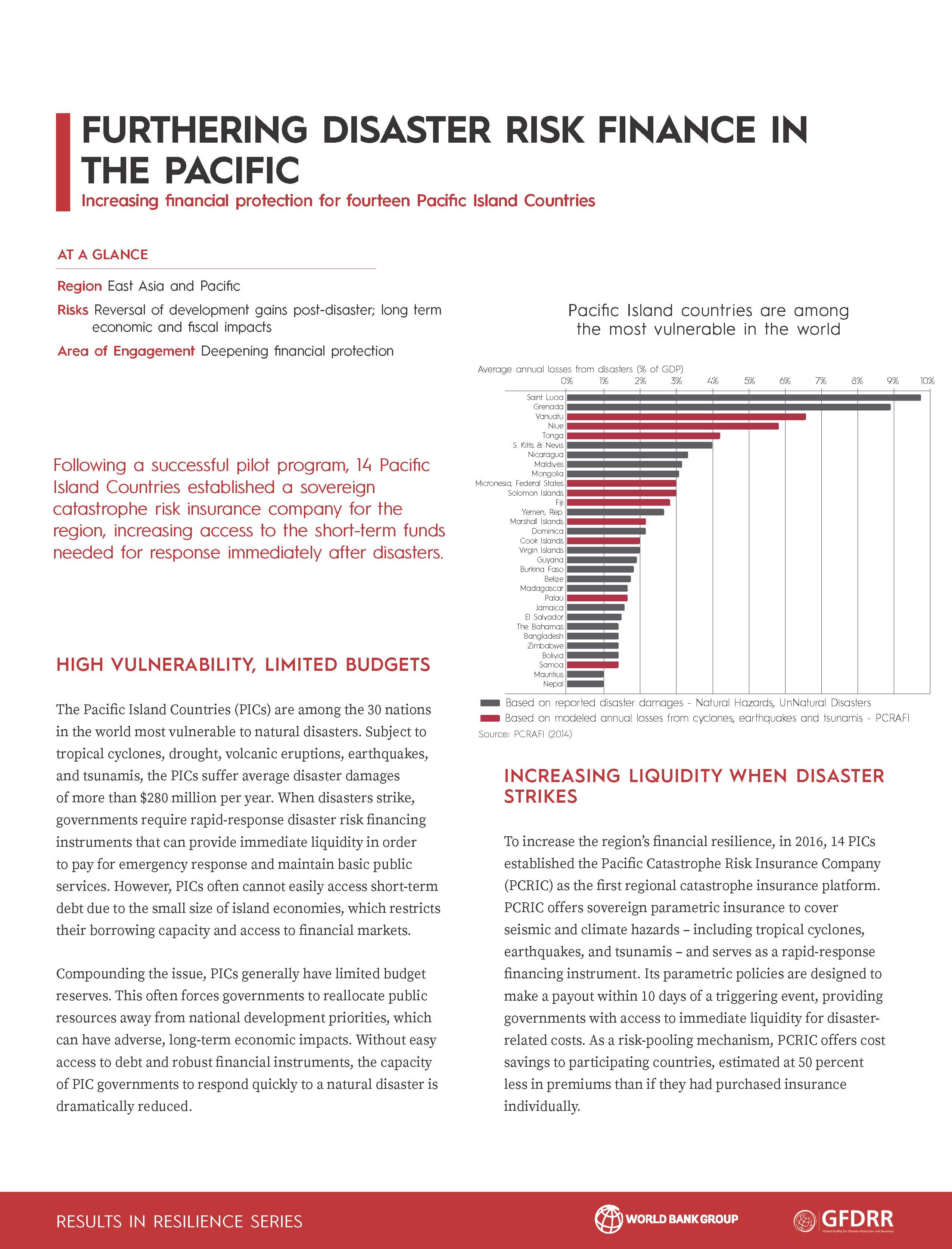
Furthering Disaster Risk Finance in the Pacific
Increasing financial protection for fourteen Pacific Island Countries
Following a successful pilot program, Pacific Island Countries established a sovereign catastrophe risk insurance company for the region, increasing resilience and access to short-term funds needed to respond to disasters.
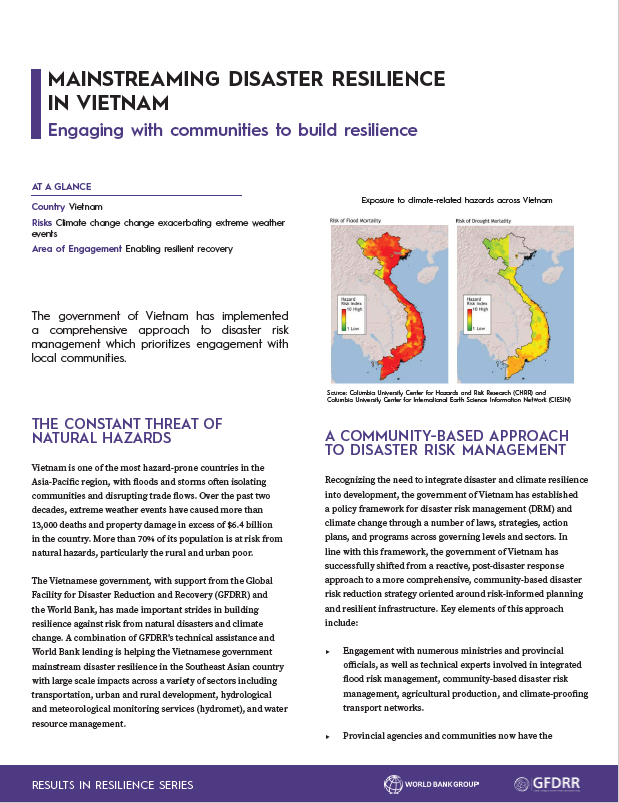
Mainstreaming Disaster Resilience in Vietnam
Engaging with communities to build resilience
The government of Vietnam has implemented a comprehensive approach to disaster risk management that prioritizes engagement with local communities.
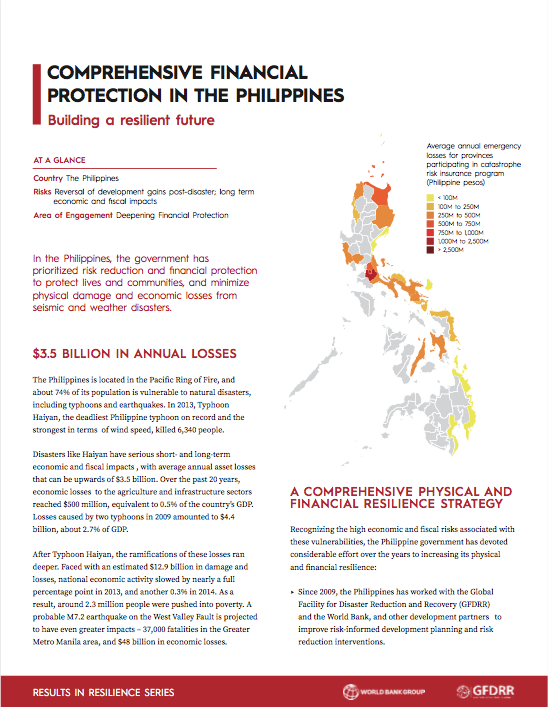
Comprehensive Financial Protection in the Philippines
Building a resilient future
In the Philippines, the government has prioritized risk reduction and financial protection to protect lives and communities, and minimize physical damage and economic losses from seismic and weather disasters.
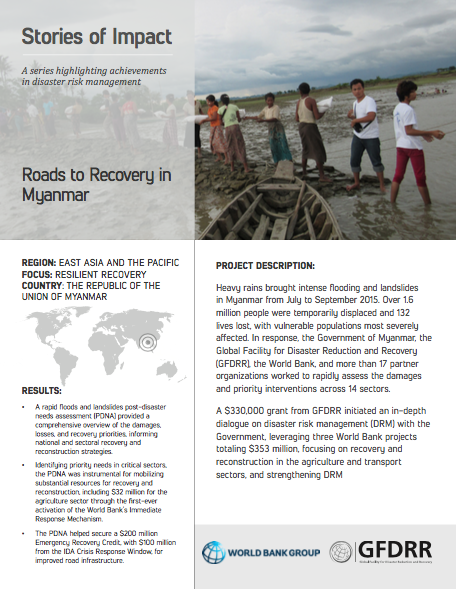
Roads to Recovery in Myanmar
After heavy rains from July through September of 2015 resulted in intense flooding and landslides, the government of Myanmar, GFDRR, the World Bank, and more than 17 partner organizations conducted a PDNA. The assessment was crucial in mobilizing resources for recovery, including through the first-ever use of the World Bank’s Immediate Response Mechanism.
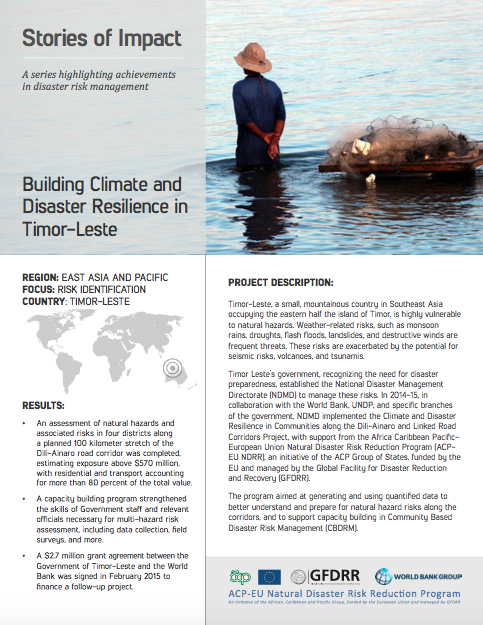
Building Climate and Disaster Resilience in Timor-Leste
With support from the GFDRR-managed Africa Caribbean Pacific-European Union Natural Disaster Risk Reduction Program (ACP-EU NDRR), Timor Leste established a program focused on generating and using quantified data to assess risk along the Dili-Ainaro and other linked road corridors.
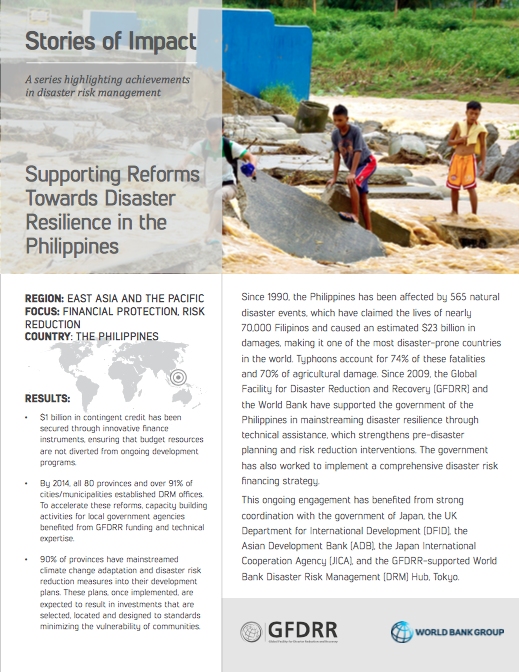
Supporting Reforms Toward Disaster Resilience in the Philippines
Since 2009 GFDRR and the World Bank have supported the government of the Philippines in mainstreaming disaster resilience through technical assistance, which strengthens pre-disaster.
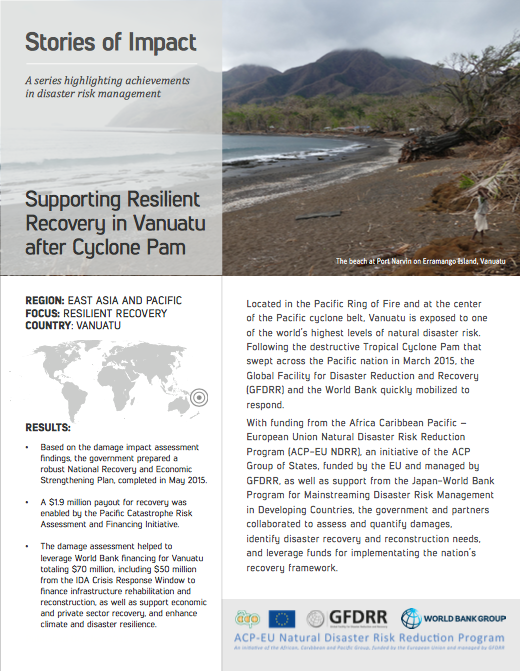
Supporting Recovery in Vanuatu after Cyclone Pam
Following the destructive Tropical Cyclone Pam that swept across the Pacific nation in March 2015, GFDRR and the World Bank quickly mobilized to respond.
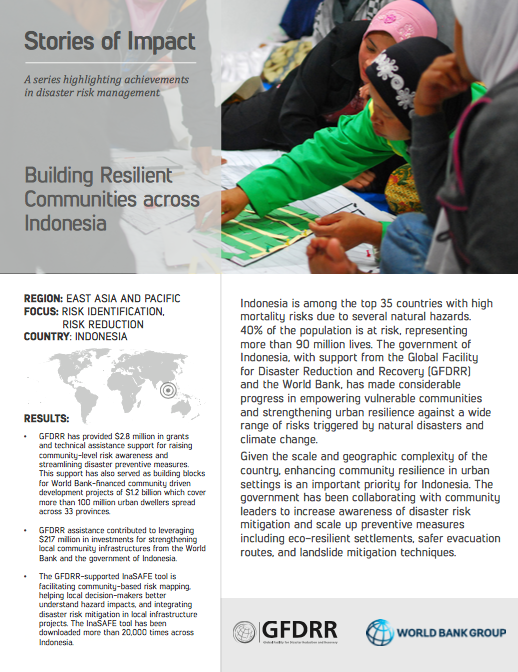
Building Resilient Communities across Indonesia
The Government of Indonesia, with support from GFDRR and the World Bank, has empowered vulnerable communities and strengthened urban resilience against a wide range of risks triggered by natural disasters and climate change.
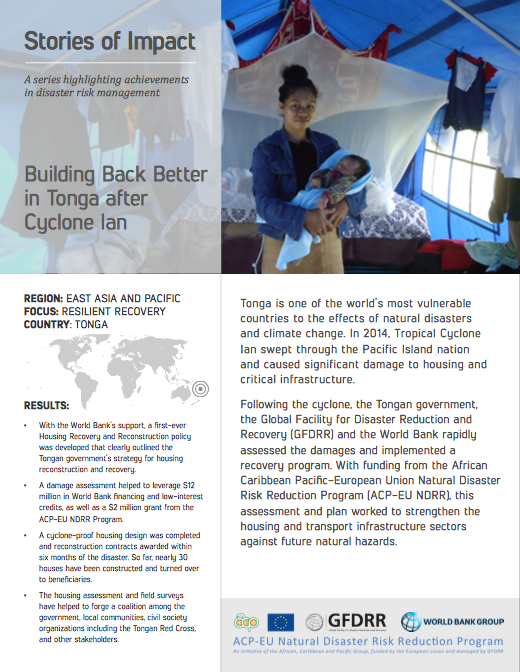
Building Back Better in Tonga after Cyclone Ian
After Tropical Cyclone Ian swept through the Pacific Island nation of Tonga in 2014, the government, the World Bank, and the Global Facility for Disaster Reduction and Recovery (GFDRR), with funding from the Africa Caribbean Pacific-European Union Natural Disaster Risk Reduction Program (ACP-EU NDRR), worked to rapidly assess the damages, and implement a recovery program which would strengthen the housing and transport infrastructure sectors against future natural hazards.
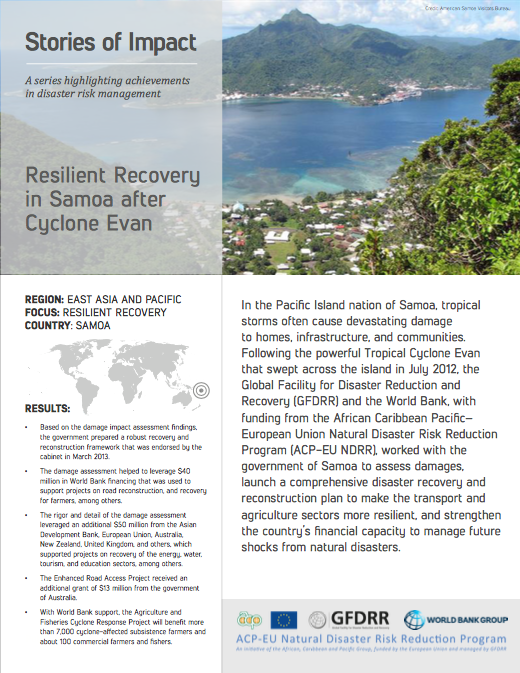
Resilient Recovery in Samoa after Cyclone Evan
Following the powerful Tropical Cyclone Evan that swept across the island of Samoa in July 2012, the World Bank and the Global Facility for Disaster Reduction and Recovery (GFDRR), with funding from the Africa Caribbean Pacific–European Union Natural Disaster Risk Reduction Program (ACP-EU NDRR), worked with the government to assess damages, launch a comprehensive disaster recovery and reconstruction plan to make the transport and agriculture sectors more resilient, and strengthen the country’s financial capacity to manage future shocks from natural disasters.
Europe and Central Asia
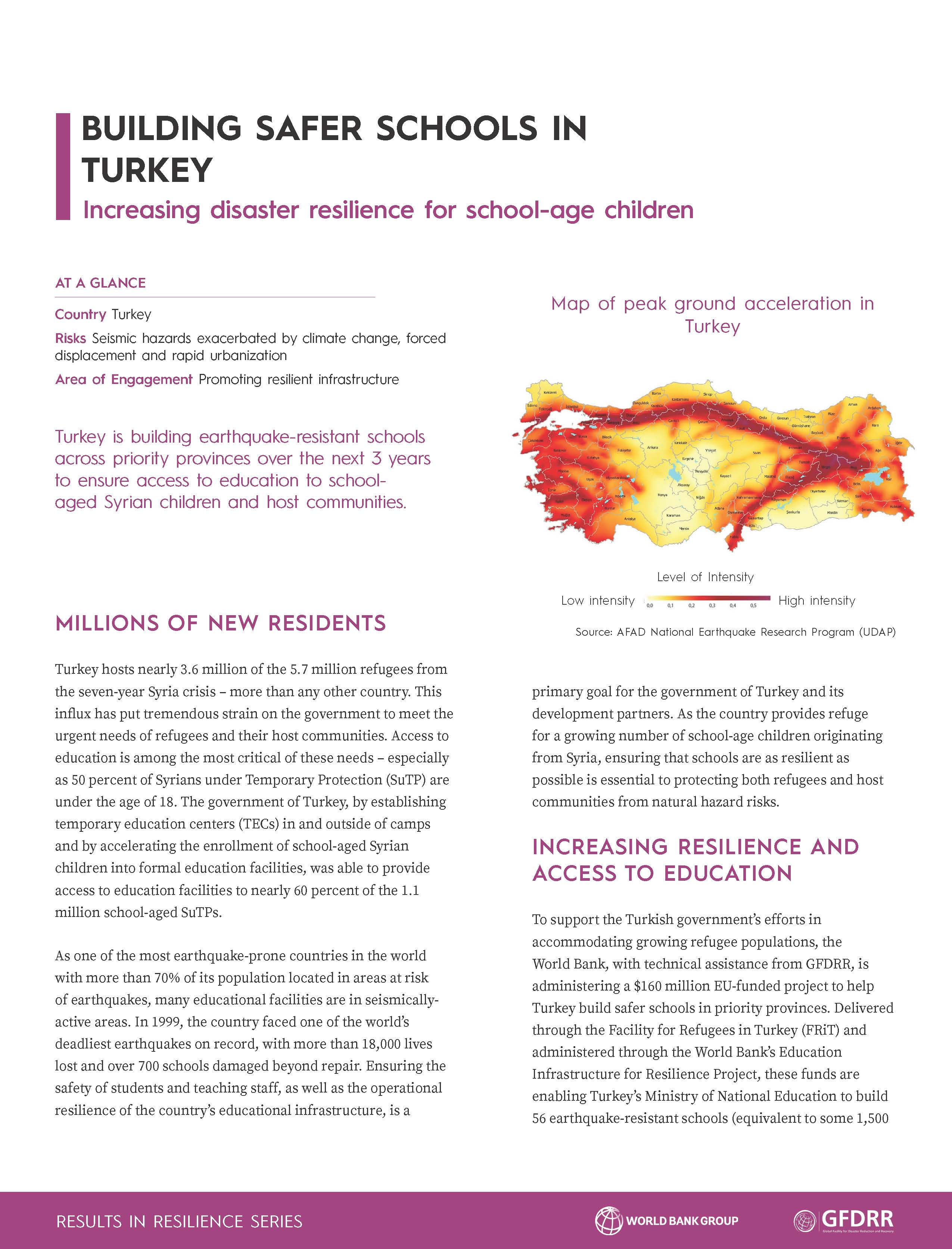
Building Safer Schools in Turkey
Increasing disaster resilience for school-age children
Turkey is building earthquake-resistant schools across priority provinces over the next 3 years to ensure access to education to school-aged Syrian children and host communities.
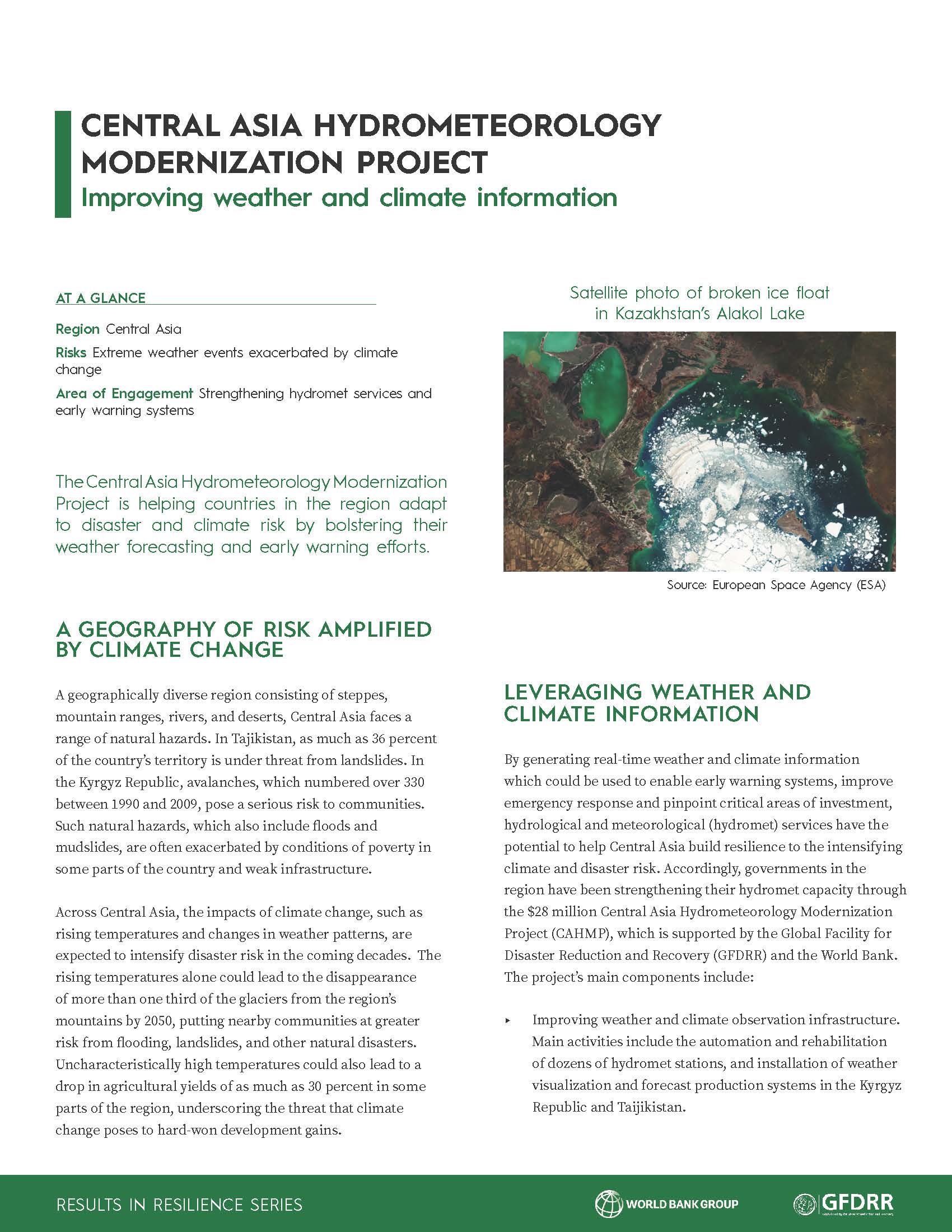
Central Asia Hydrometeorology Modernization Project
Improving weather and climate information
The Central Asia Hydrometeorology Modernization Project is helping countries in the region adapt to disaster and climate risk by bolstering their weather forecasting and early warning efforts.
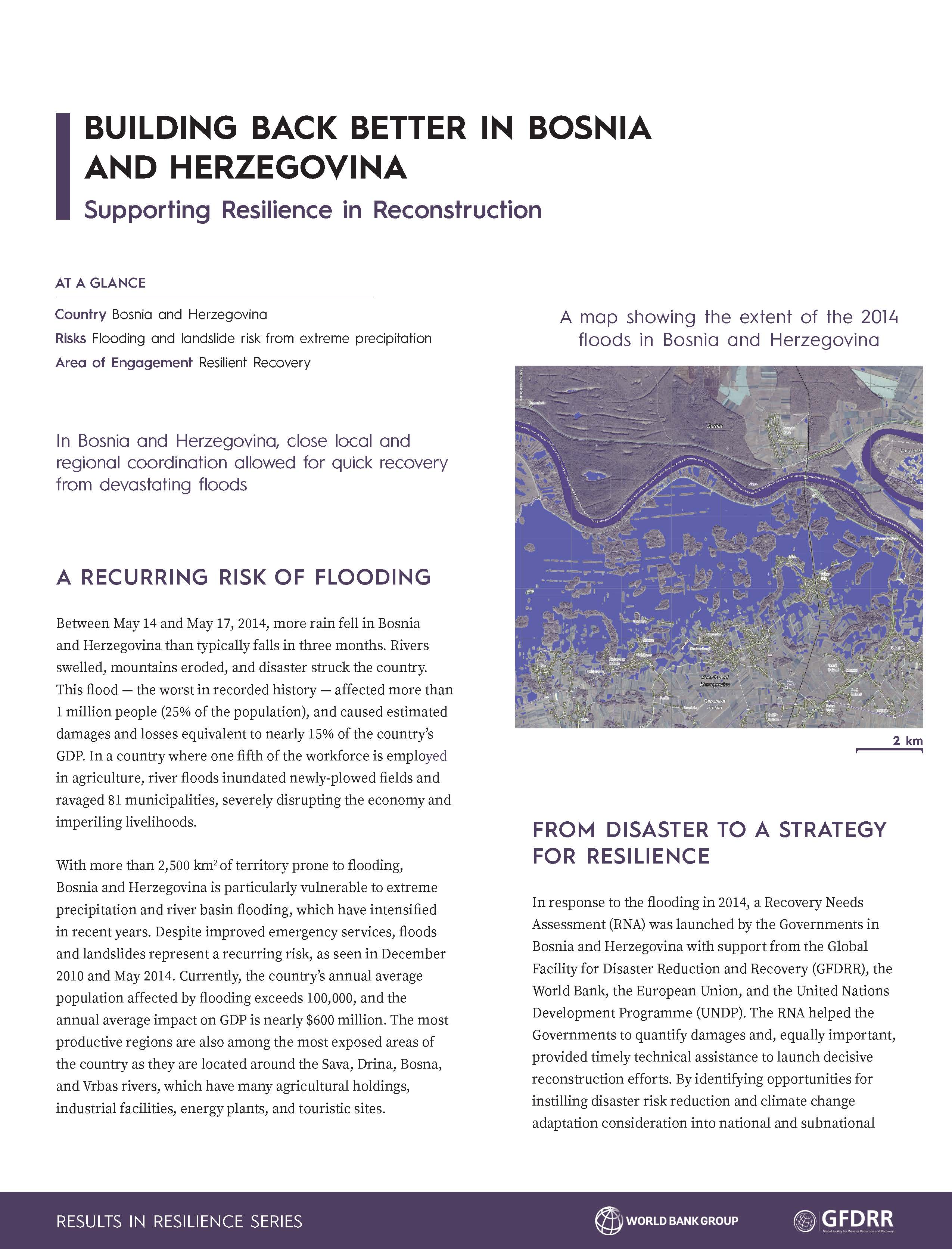
Building Back Better in Bosnia and Herzegovina
Supporting resilience in reconstruction
In Bosnia and Herzegovina, close local and regional coordination allowed for quick recovery from devastating floods.
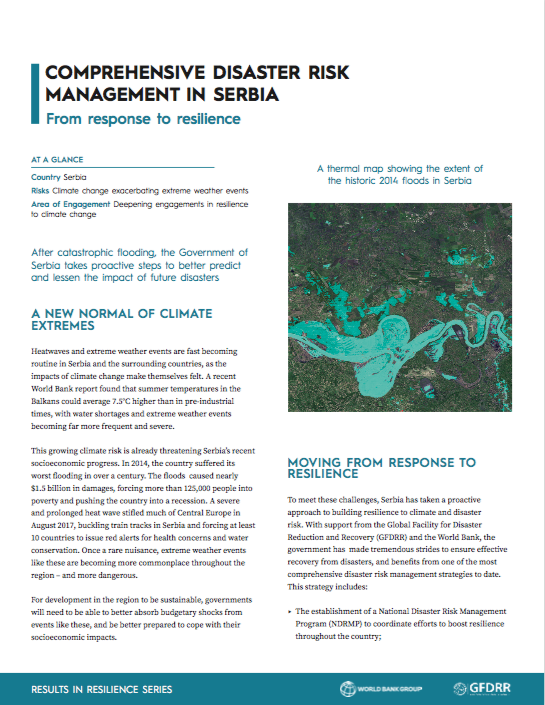
Comprehensive Disaster Risk Management in Serbia
From response to resilience
After catastrophic fooding, the Government of Serbia takes proactive steps to better predict and lessen the impact of future disasters.
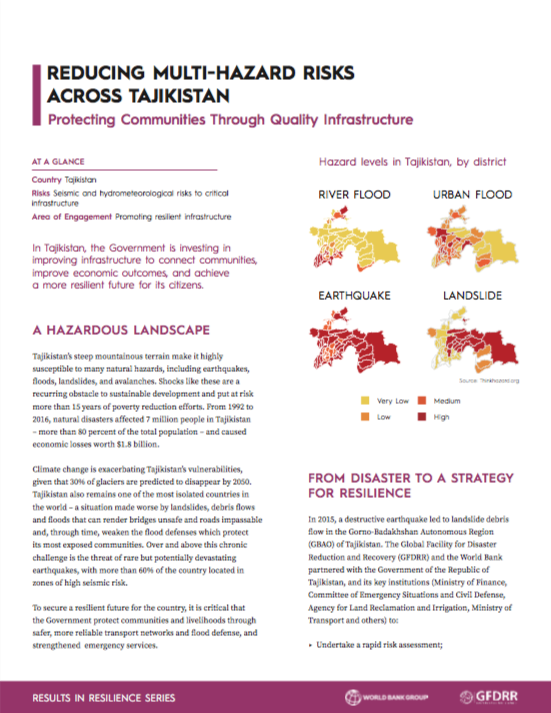
Reducing Multi-Hazard Risks Across Tajikistan
Protecting communities through quality infrastructure
In Tajikistan, the Government is investing in improving infrastructure to connect communities, improve economic outcomes, and achieve a more resilient future for its citizens.
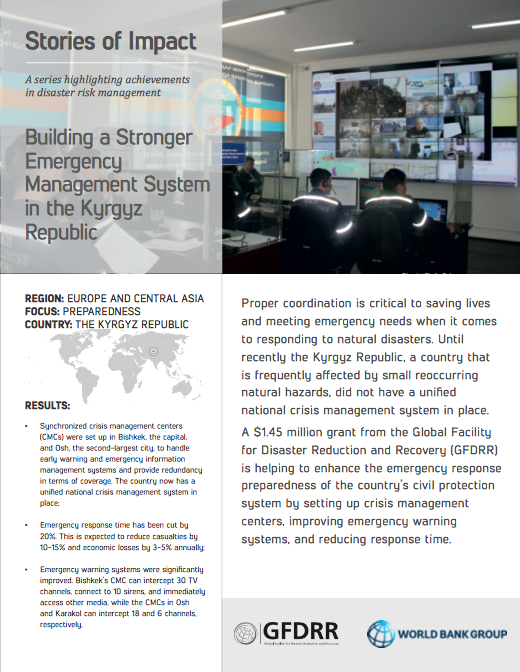
Building a Stronger Emergency Management System in the Kyrgyz Republic
A $1.45 million grant from GFDRR is helping to enhance the emergency response preparedness of the country’s civil protection system by setting up crisis management centers, improving emergency warning systems, and reducing response time.
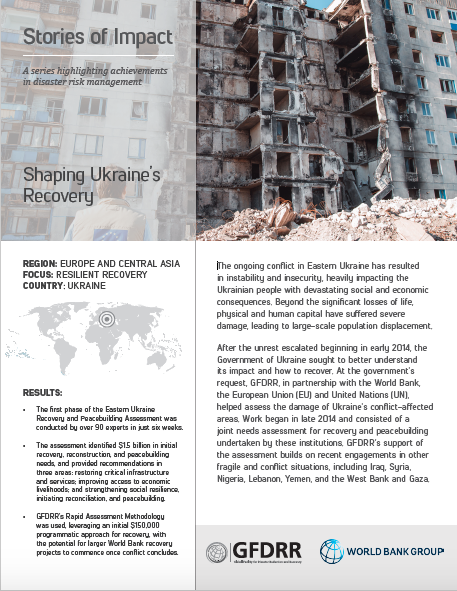
Shaping Ukraine's Recovery
After unrest escalated beginning in early 2014, the Government of Ukraine sought to better understand its impact and how to recover. At the government’s request, GFDRR, in partnership with the World Bank, the European Union and United Nations, helped assess the damage of Ukraine’s conflict-affected areas.
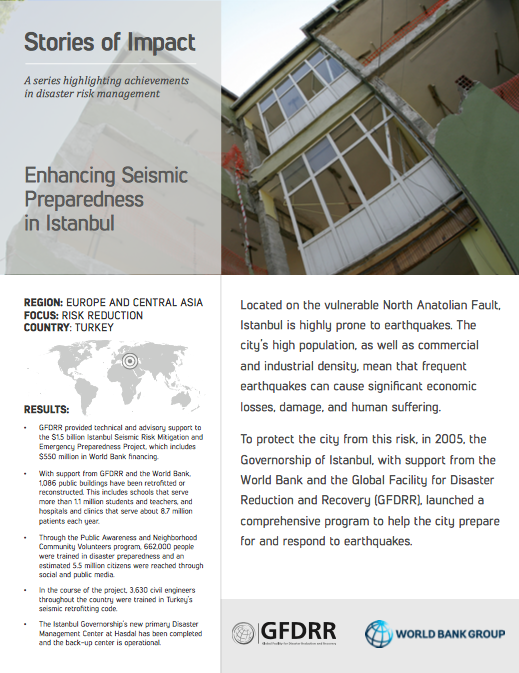
Enhancing Seismic Preparedness in Istanbul
To protect the city from this risk, in 2005, the Governorship of Istanbul, with support from the World Bank and GFDRR, launched a comprehensive program to help the city prepare for and respond to earthquakes.
Latin America and the Caribbean
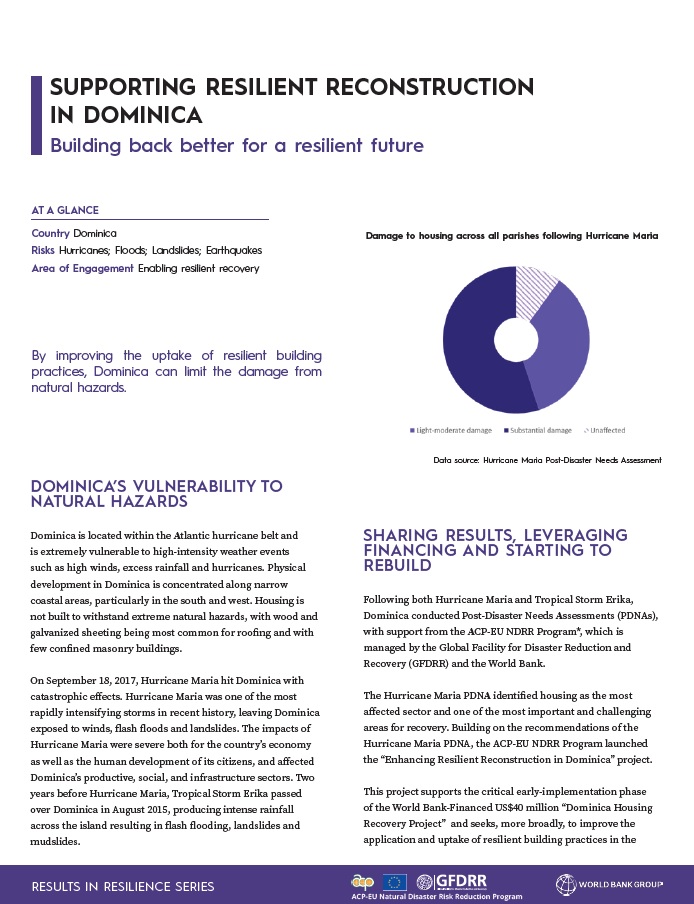
Supporting Resilient Reconstruction in Dominica
Building back better for a resilient future
By improving the uptake of resilient building practices, Dominica can limit the damage from natural hazards.
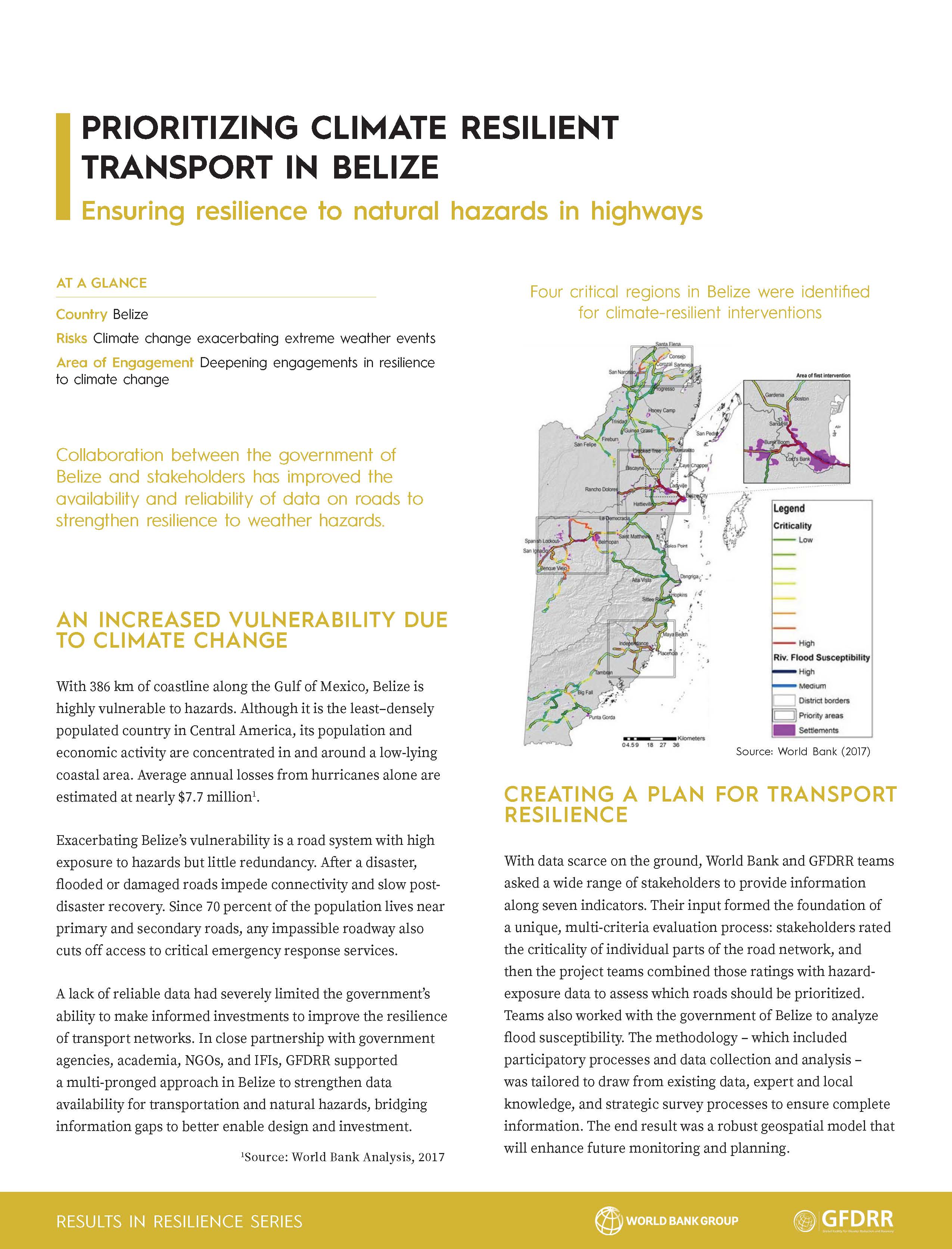
Prioritizing Climate Resilient Transport in Belize
Ensuring resilience to natural hazards in highways
Collaboration between the government of Belize and stakeholders has improved the availability and reliability of data on roads, strengthening resilience to weather hazards.
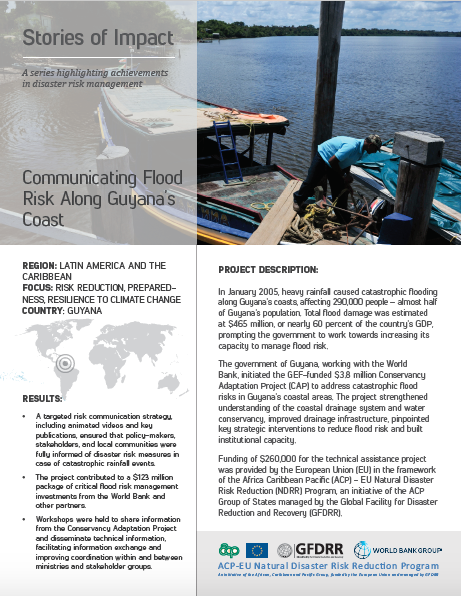
Communicating Flood Risk Along Guyana’s Coast
After catastrophic flooding in January 2005, the government of Guyana launched the Conservancy Adaptation Project to address flood risks in the country’s coastal areas, disseminating vital technical information and key knowledge on disaster risk measures.
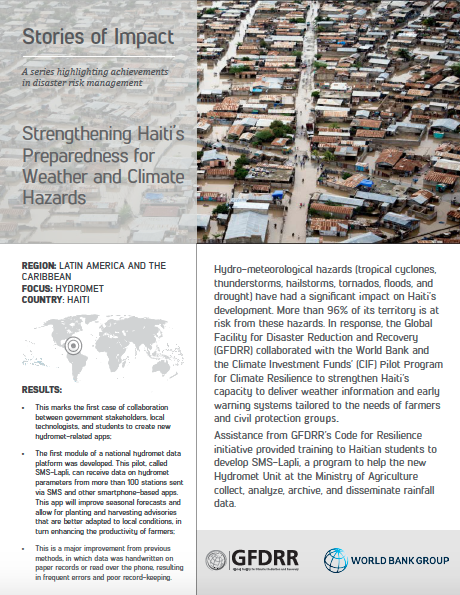
Strengthening Haiti's Preparedness for Weather and Climate Hazards
GFDRR helped to strengthen Haiti’s capacity to deliver weather information and early warning systems via its Code for Resilience initiative.
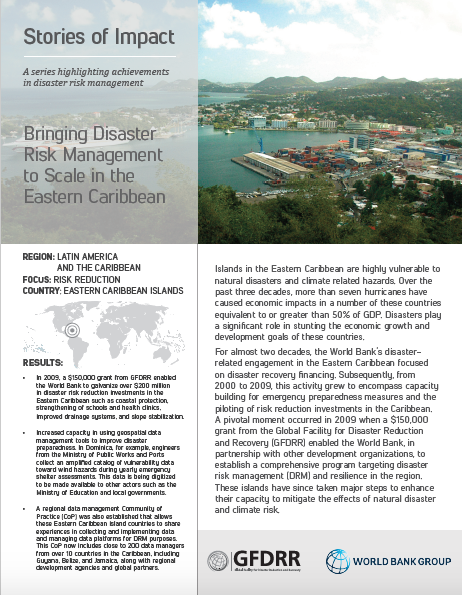
Bringing Disaster Risk Management to Scale in the Eastern Caribbean
A $150,000 grant from GFDRR enabled the World Bank, in partnership with other development organizations, to establish a comprehensive program targeting disaster risk management and resilience in the Eastern Caribbean.
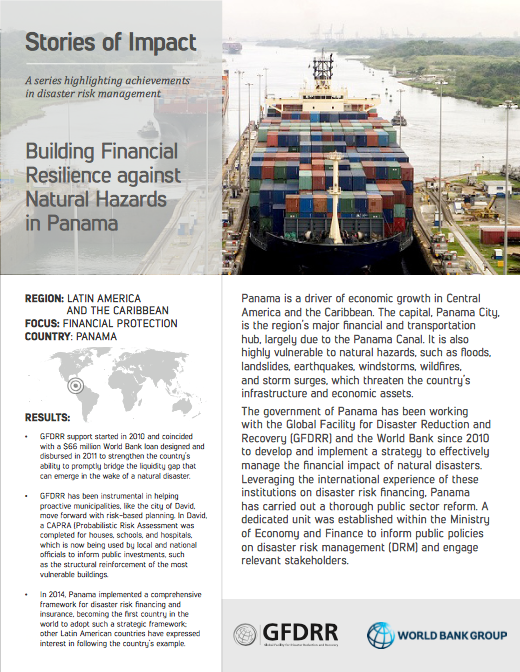
Building Financial Resilience against Natural Hazards in Panama
The Government of Panama has worked with the World Bank and GFDRR since 2010 to develop and implement a strategy to effectively manage the financial impact of natural disasters.
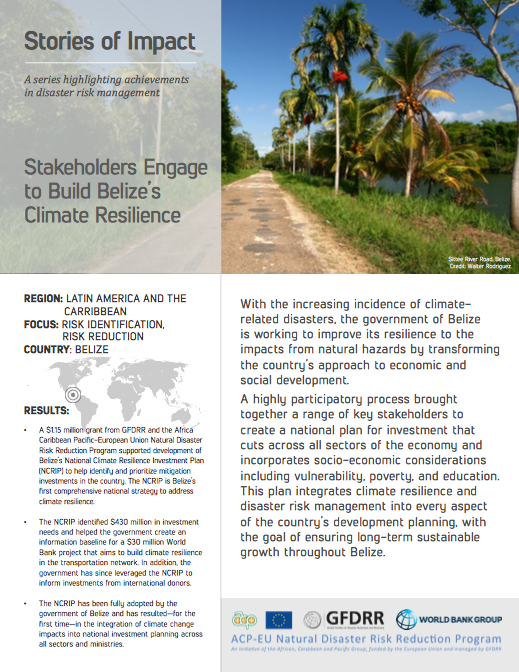
Stakeholders Engage to Build Belize’s Climate Resilience
With the increasing incidence of climate-related disasters, the Government of Belize is working to improve its resilience by transforming the country’s approach to economic and social development with a national plan that cuts across all sectors of the economy.
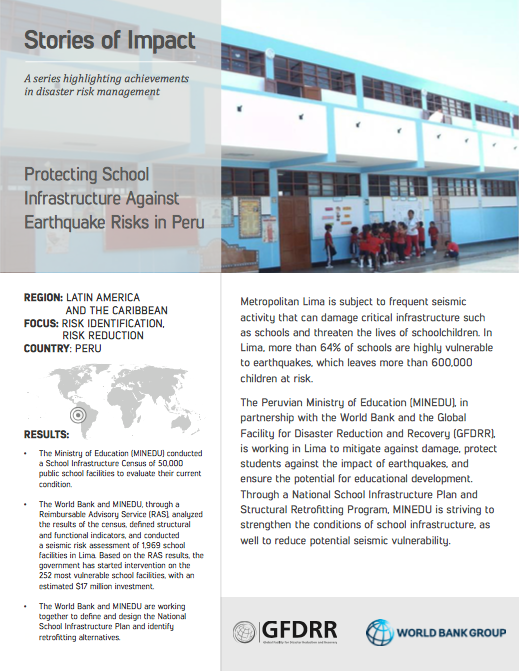
Protecting School Infrastructure Against Earthquake Risks in Peru
The Peruvian Ministry of Education (MINEDU) conducted a School Infrastructure Census of 50,000 public school facilities to evaluate their current condition. With GFDRR support, the World Bank and MINEDU conducted a seismic risk assessment of 1,969 school facilities in Lima alone. Based on the results, the government has started intervention on the 252 most vulnerable school facilities, with an estimated $17 million investment.
Middle East and North Africa
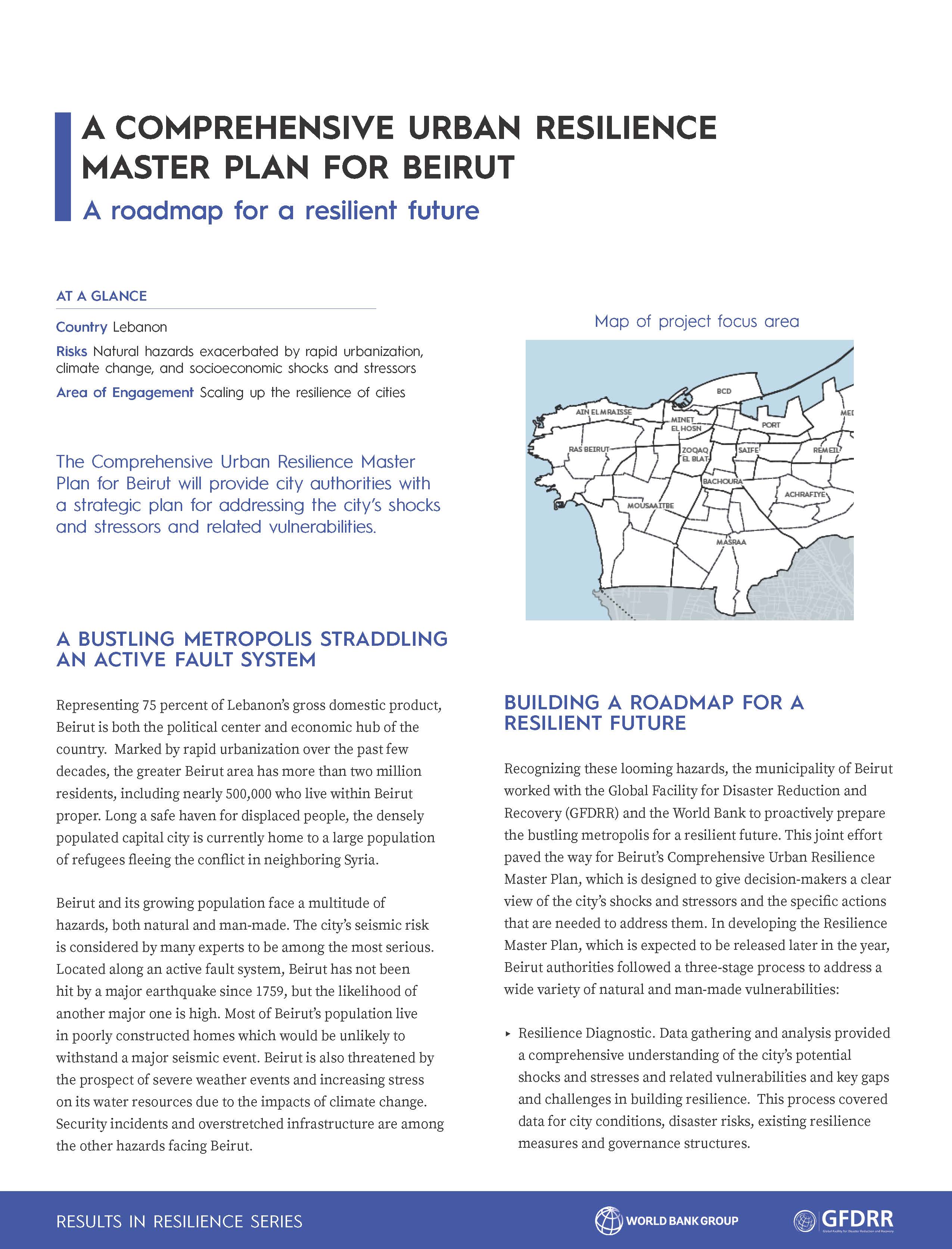
Comprehensive Urban Resilience Master Plan for Beirut
A roadmap for a resilient future
The Comprehensive Urban Resilience Master Plan for Beirut will provide city authorities with a strategy for addressing the city’s vulnerabilities to shocks and stressors.
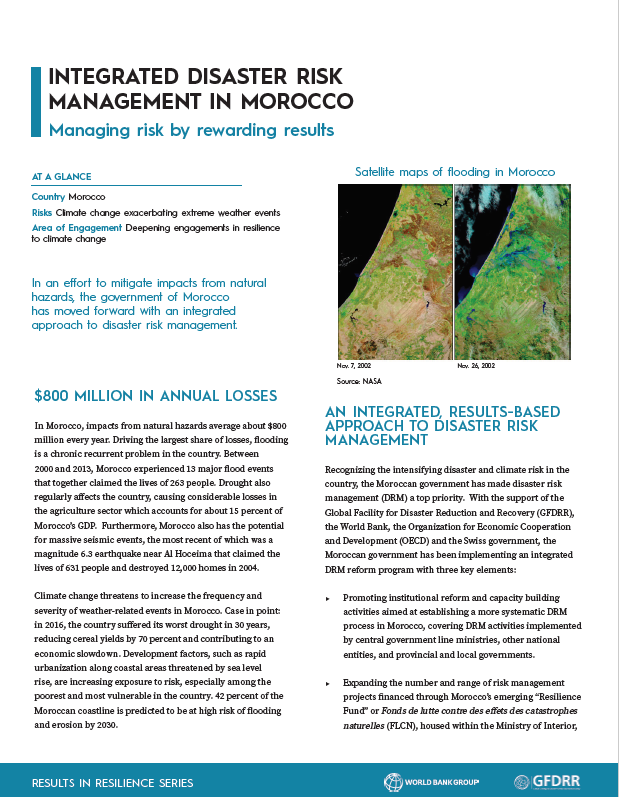
Integrated Disaster Risk Management in Morocco
Managing risk by rewarding results
In an effort to mitigate impacts from natural hazards, the government of Morocco has adopted an integrated approach to disaster risk management.
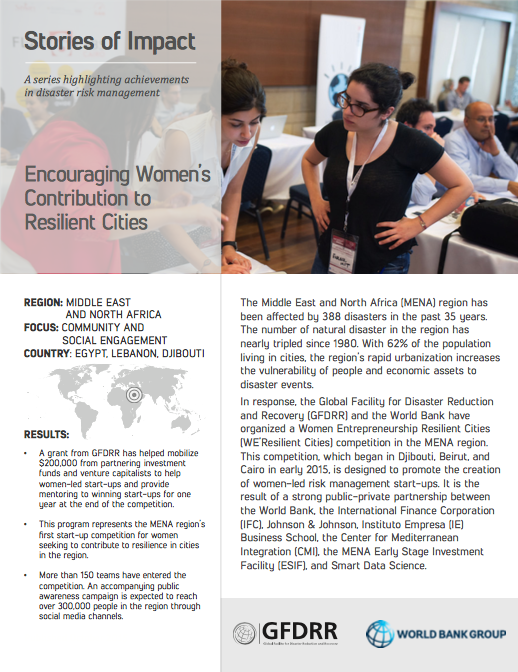
Encouraging Women’s Contribution to Resilient Cities
The World Bank and GFDRR have organized a Women Entrepreneurship Resilient Cities (WE’Resilient Cities) competition in the MENA region. This competition, which began in Djibouti, Beirut, and Cairo in early 2015, is designed to promote the creation of women-led risk management start-ups.
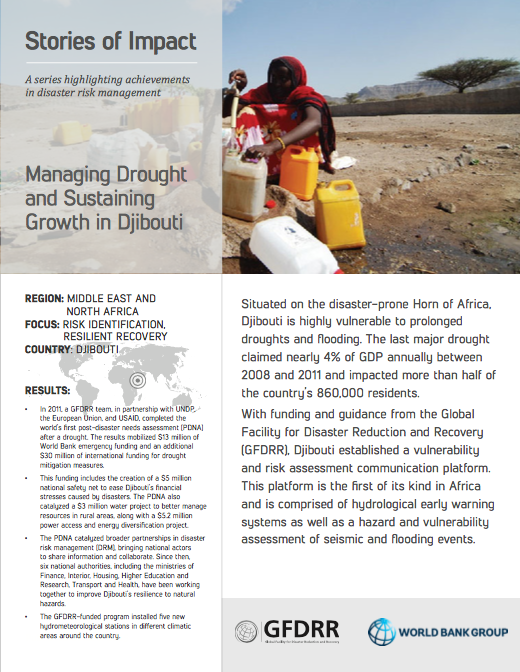
Managing Drought, Sustaining Growth in Djibouti
With funding and guidance from the Global Facility for Disaster Reduction and Recovery (GFDRR), Djibouti established a vulnerability and risk assessment communication platform. This platform is the first of its kind in Africa and is comprised of hydrological early warning systems, as well as a hazard and vulnerability assessment of seismic and flooding events.>
South Asia
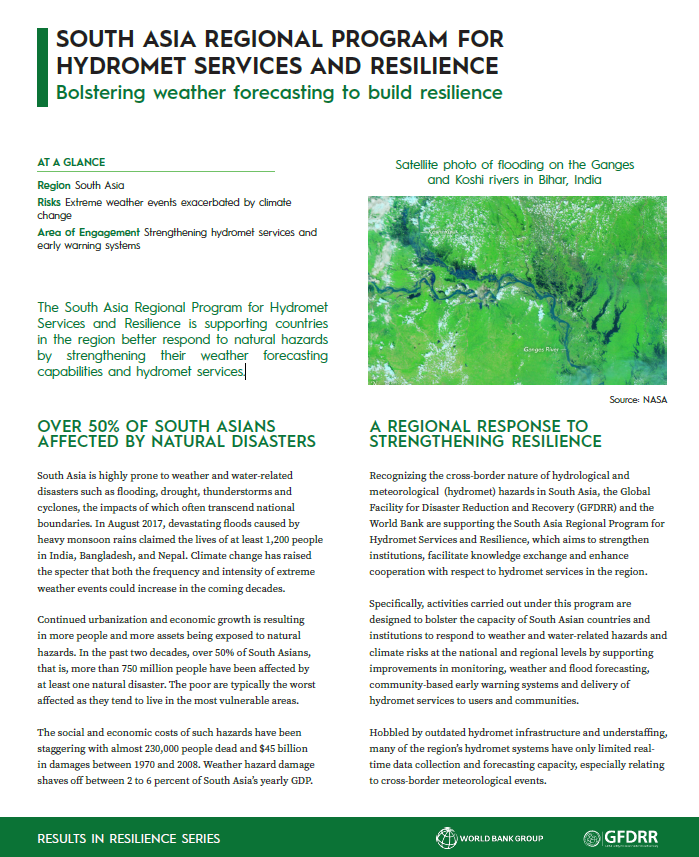
South Asia Regional Program for Hydromet Services and Resilience
Bolstering weather forecasting to build resilience
The South Asia Regional Program for Hydromet Services and Resilience is supporting countries in the region better respond to natural hazards by strengthening their weather forecasting capabilities and hydromet services.
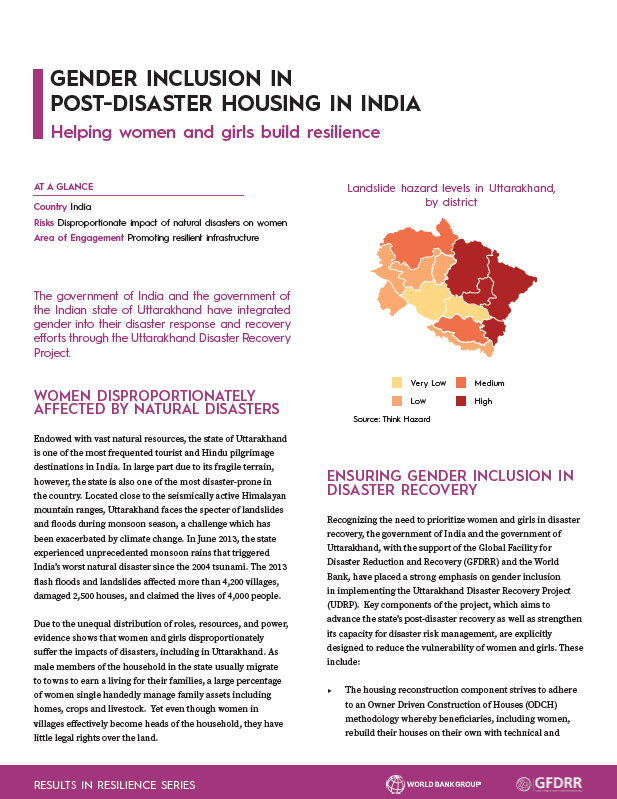
Gender Inclusion in Post-Disaster Housing in India
Helping women and girls build resilience
The government of India and the government of the Indian state of Uttarakhand have integrated gender into their disaster response and recovery efforts through the Uttarakhand Disaster Recovery Project.
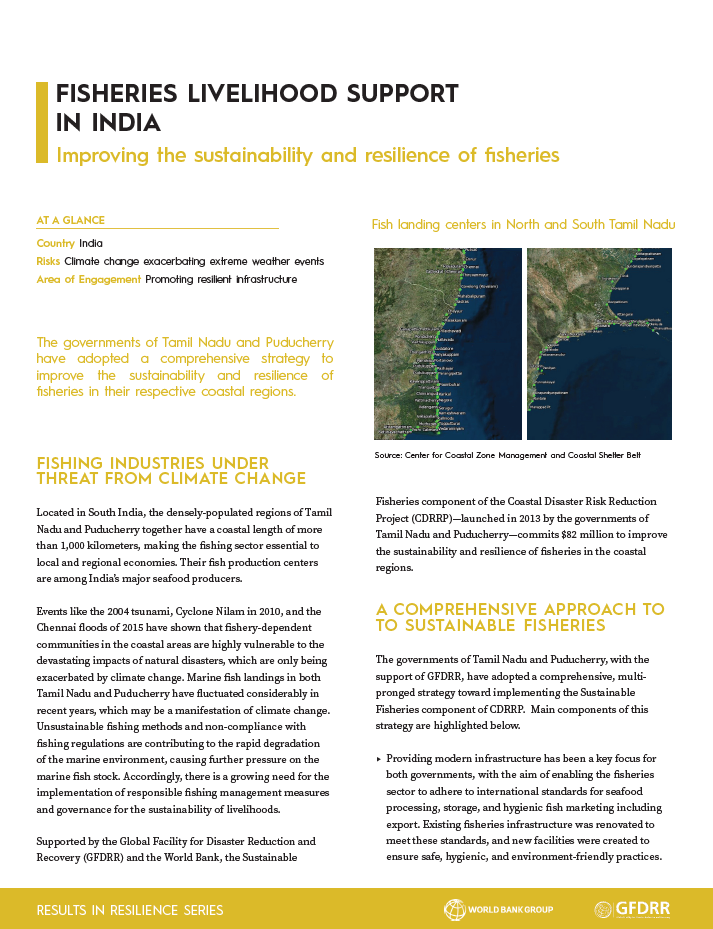
Fisheries Livelihood Support in India
Improving the sustainability and resilience of fisheries
The governments of Tamil Nadu and Puducherry have adopted a comprehensive strategy to improve the sustainability and resilience of fisheries in their respective coastal regions.
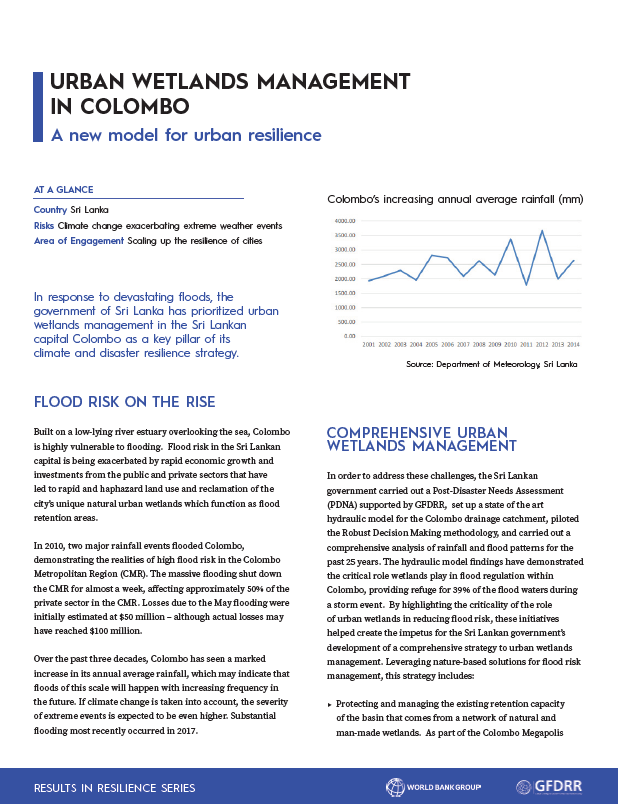
Urban Wetlands Management in Colombo
A new model for urban resilience
In response to devastating floods, the government of Sri Lanka has prioritized urban wetlands management in the Sri Lankan capital Colombo as a key pillar of its climate and disaster resilience strategy.
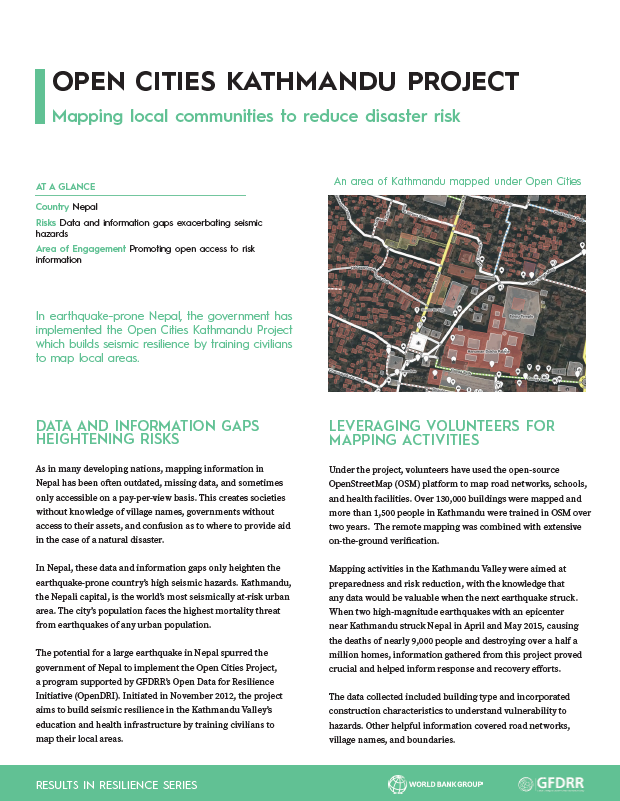
Mapping to Build Resilience in Kathmandu
Mapping local communities to reduce disaster risk
In earthquake-prone Nepal, citizens trained to map local areas are helping in the government’s effort to build seismic resilience.
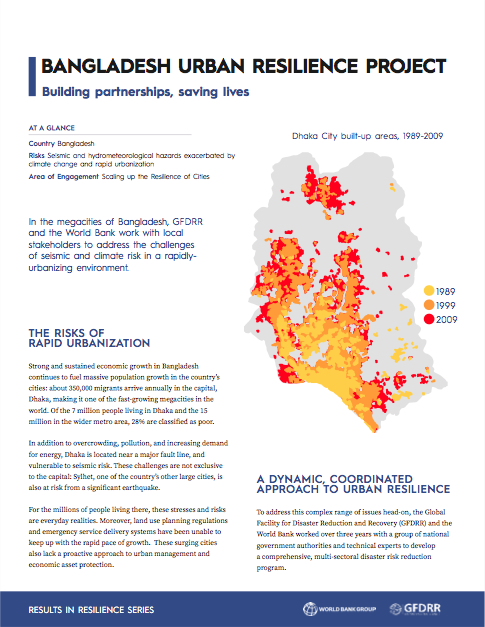
Bangladesh Urban Resilience Project
Building partnerships, saving lives
In the megacities of Bangladesh, GFDRR and the World Bank work with local stakeholders to address the challenges of seismic and climate risk in a rapidly- urbanizing environment.
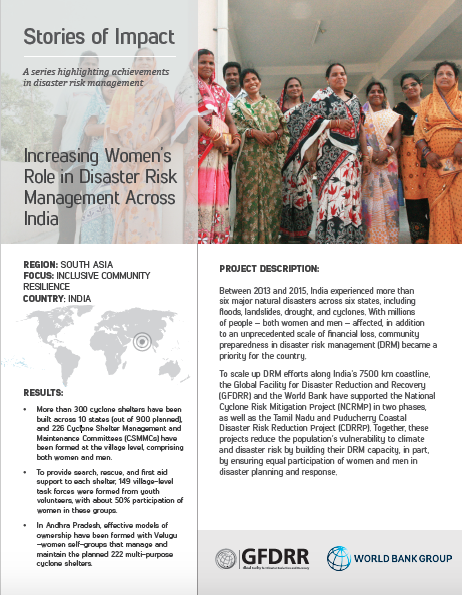
Increasing Women’s Role in Disaster Risk Management Across India
Two GFDRR- and World Bank-supported projects have reduced vulnerability by building the disaster risk management of local communities – with equal participation of men and women in disaster planning as the key component. The project has resulted in more than 300 cyclone shelters so far, with 226 maintenance committees and 149 village-level emergency-response task forces that comprise both women and men.
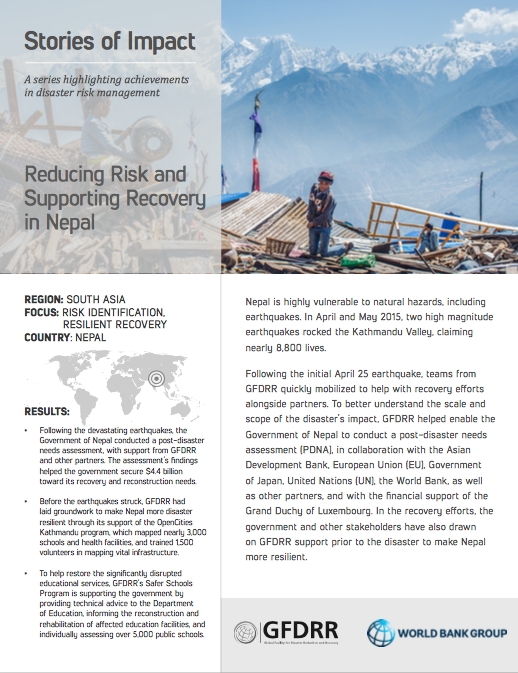
Reducing Risk and Supporting Recovery in Nepal
Following the initial April 25 earthquake, GFDRR helped enable the Government of Nepal to conduct a post-disaster needs assessment, in collaboration with the Asian Development Bank, European Union, Government of Japan, United Nations, the World Bank, as well as other partners, and with the financial support of the Grand Duchy of Luxembourg.
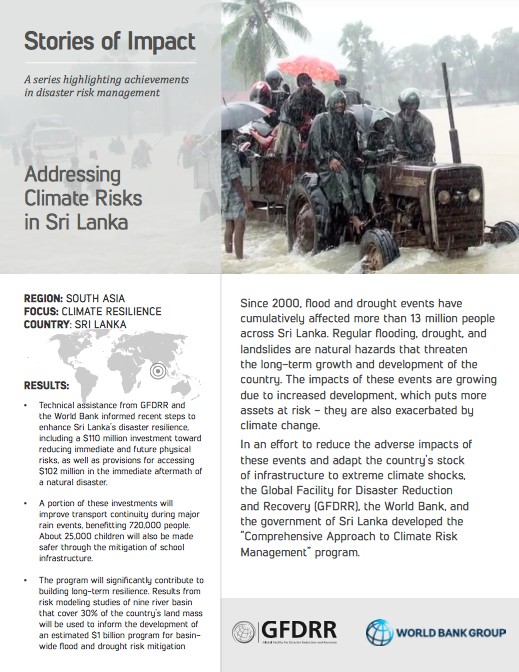
Addressing Climate Risks in Sri Lanka
Technical assistance from GFDRR and the World Bank informed recent steps to enhance Sri Lanka’s disaster resilience, including a $110 million investment towards reducing immediate and future physical risks as well as provisions for accessing $102 million in the immediate aftermath of a natural disaster.
Building Coastal Resilience in India
Effective disaster risk management significantly reduced casualties from Cyclone Phailin, and GFDRR and other partners are supporting the strengthening and scaling up of these efforts through the National Cyclone Risk Mitigation Project (NCRMP).
Rapidly Assessing Flood Damage in Uttarakhand, India
GFDRR and partners conducted a Joint Rapid Damage Needs Assessment (JRDNA) for the Uttarakhand region soon after the devastating 2013 monsoons, completing a thorough analysis of damage and providing the necessary foundation for recovery efforts to begin.
